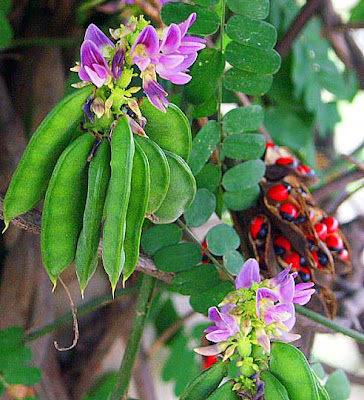 Abrus precatorius (jequitry -seeds)
Abrus precatorius (jequitry -seeds)
 Abrus precatorius (jequitry -whole plant)
Abrus precatorius (jequitry -whole plant)
TOXIC BEAUTIES: A WORK IN PROGRESS The common names of herbs which are considered toxic are listed in parentheses () in the herb lists. These herbs need to be respected and the user should proceed with caution!
Here is a short list of some of the most toxic herbs known in European and North American botanical medicine, as well as a few ornamental plants found in many households. None should be used except under the direct medical supervision of a naturopathic physician:
· Abrus precatorius (jequitry)The toxin present in Abrus precatorius is a close relative toricincalled abrin. One molecule of abrin will inactivate up to 1,500ribosomesper second. Symptoms are identical to those of ricin, except that the fatal dose of ricin is approximately 75 times greater than the fatal dose of abrin. Abrin can kill with a circulating amount of less than 3 μg (micrograms).· Aconitum spp (monkshood)Marked symptoms appear within a few minutes of the administration of a poisonous dose ofaconite.There is a sensation of burning, tingling, and numbness in the mouth, and of burning in the abdomen. Usually death ensues before a numbing effect on theintestinecan be observed. A common antidote is atropine.· Aleurites fardii (tung-oil tree)Although it is dangerously toxic, tung oil has been used to treat skin conditions caused by parasitic worms. Tung extracts have recently shown potential as termite control compounds. Tung-oil can be used as an incredible water repellent used in the paper industry. It is completely miscible with many solvents and is used to improve their drying time by changing the surface tension of paints and varnishes.
· Alocasia macrorhiza
· Amanita spp. (deathcap mushroom)
· Anemone pulsatilla (pasque flower)
· Anhalonium spp. (mescale)
· Atropa belladonna (deadly nightshade)
· Blighia sapida (akee)
· Chelidonium majalis (greater celandine)
· Cicuta spp. (water hemlock)
· Colchicum autumnale (autumn crocus)
· Colocasia antiquorum (elephant’s ear)
· Conium maculatum (poison hemlock)
· Convallaria majalis (lily of the valley)
· Cytisus scoparius (scot’s broom)
· Daphne mezereum (mezereon)
· Datura spp. (thornapple, jimson weed)Jimson weed (Datura stramonium),A member of the nightshade family (related to the potato). All parts are toxic. As little as one-half teaspoonful of the seeds has been reported to cause death from cardiac and pulmonary arrest. The chief active ingredients of jimson weed are hyoscyamine and scopolamine, whose primary actions are anticholinergic. These compounds are mainly excreted by the kidneys, although there is some hepatic metabolization. The plant was used to treat asthma in the 1600s. · Delphinium spp. (larkspur)
· Dicentra spp. (dutchman’s breeches, squirrel corn, bleeding heart)
· Dieffenbachia seguine (dumbcane)
· Digitalis purpurea (foxglove)
· Eupatorium rugosum (white snakeroot)
· Euphorbia spp. (spurge, poinsettia))
· Gelsemium sempervirens (yellow jessamine)
· Hedera helix (English ivy)
· Helleborus niger (hellebore)
· Hippomane mancinella (manchineel tree)
· Hyocyamus niger (henbane)
· Ilex aquifolium (English holly)
· Ipomoea spp. (morning glory)
· Jatropha curas (physic nut)
· Kalmia spp. (mountain laurel)
· Laburnum anagyroides (golden-chain)
· Lantana camara (lantana)
· Melia azedarach (chinaberry tree)
· Metopium toxiferum (poisonwood tree)
· Narcissus spp. (daffodil, jonquil)
· Nerium oleander (oleander)
· Papaver spp. (poppy)
· Phoradendron flavescens (American mistletoe)
· Phytolacca Americana (pokeweed)
· Podophyllum peltatum (mayapple)
· Poinciana gilliesii (bird of paradise)
· Psilocybe mexicana (psychotropic mushrooms)
· Rauwolfia serpentaria (rauwolfia)
· Ranunculus spp. (buttercup)
· Rhododendron spp. (rhododendron)
· Rhus toxicodendron (poison ivy)
· Ricinus communis (castor bean)
· Robinia pseudoacacia (black locust)
· Skimmia japonica (skimmia)
· Solandra spp. (chalice-vine)
· Solanum spp. (nightshade)
· Taxus spp. (yew)
· Thevetia peruviana (yellow oleander)
· Veratrum spp. (hellebore)
· Viscum album (European mistletoe)
· Wisteria spp. (wisteria)
· Xanthosoma sagittifolium (tannia, tanier)
· Zamia integrifolia (comfort root) Some notes:The Ranunculaceae (buttercup) family has a highly irritative latex in the stems which can cause contact dermatitis when harvesting and severe gastrointestinal irritation if consumed. For this reason, the stems are never used internally and used externally only for the removal of warts and other skin lesions. The entire family of plants should be avoided during pregnancy and breastfeeding. Some Asteraceae (daisy) family members (such as Taraxacum or dandelion) have a similar, but less caustic, latex in their stems. Avoid use of stems for internal use from both of these families. Dandelion root or taraxacum radix is safe to use during pregnancy or breast-feeding but not the stem. Papaveracea (poppy) family plants are generally high in alkaloids which can have a profound effect on the nervous system. Use only with extreme care and under the supervision of a botanically trained physician. Do not use these plants during pregnancy or lactation.Apiaceae (celery) family plants often contain furanocoumarins that in high doses can cause a hypersensitivity to the sun leading to a condition known as photodermatitis. These coumarin-like compounds can also cause increased bleeding especially when mixed with other blood anticoagulants such as warfarin and aspirin. Furanocoumarins are found in other specific plants from other families and care should be used to avoid excessive sun exposure when using these herbs. Members of the Anacardiaceae (cashew) family which includes Rhus toxicodendrons (poison ivy) can cause extreme allergic reactions from contact dermatitis to anaphylaxis. Use with extreme caution only under a doctor’s supervision and never in pregnancy, breastfeeding or early childhood.
要盡心, 盡性, 盡意, 盡力愛主你的神 和愛人如己(Luke 10:27 NIV Bible) Dr. Gordon & Yourself: Solutions Together http://www.gordonyourself.com. GY BLOG via AnD/google is the